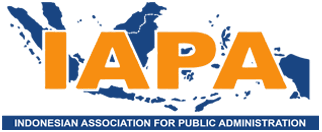A Content Analysis of e-Government Practice in Indonesia: The Case of Pontianak Municipality
DOI:
https://doi.org/10.21776/ub.jpas.2018.003.01.2Keywords:
e-Government, Indonesia, content analysisAbstract
This paper aims to describee how the implementation of E-Government within public service provision in Pontianak City, West Kalimantan, Indonesia. This paper empirically investigated the implementation of e-Government by conducting a content analysis of the website portals developed by agencies under the jurisdiction and direction of Pontianak Municipality. The findings of the paper indicate that most of websites developed by government agencies vary in terms of e-government categories consisting of G2C, G2B, G2G, G2N, and G2E. In addition, those are in enhanced presence stage that means only employ e-Government to provide dynamic, specialized and regularly updated information. Based on the results, this paper suggests that the government needs to develop standards for agencies in terms of website design to optimize and promote the sustainable development through the benefits offered by e-Government. Despite having an important contribution for academics and practitioners, this study produced rather limited results because the author conducted the research only on agencies in a local government sphere, that is Pontianak Municipality. Therefore, it is highly recommended for further studies to do the research on a wider scope.
References
ASEAN. (2004). E-Readiness Assessment Guide: ASEAN Secretariat. Available at http://unpan1.un.org/intradoc/groups/public/documebts/APCITY?UNPAN007633.pdf. [Accessed on 12 January 2018].
Athmay et. al. (2016). E-Government Adoption and User’s Satisfaction: An Empirical Investigation. EuroMed Journal of Business, Vol. 11, No. 1, pp. 23-30.
Eliassen, Kjell A., & Sitter, Nick. (2008). Understanding Public Management. London: SAGE Publications, Ltd.
Fan J. and Yang W. (2015). Study on E-Government Services Quality: The Integration of Online and Offline Services. Journal of Industrial Engineering and Management, Vol 8 (3), pp. 693-718.
Fang, Zhiyuan. (2002). E-Government in Digital Era: Concept, Practice, and Development. International Journal of The Computer, The Internet and Management, Vol. 10, No. 2, pp. 1-22.
Forman, M. A. H. (2005). E-Government: Using IT to Transform the Effectiveness and Efficiency of Government. Available at http://go.worldbank.org/XDSYI1P0S0. [Accessed on 10 January 2018].
Graham, S. , & Aurigi, A. (1997). Virtual Cities, Social Polarisation, and the Crisis in Urban Public Space. Journal of Urban Technology, Vol. 4 (1), pp. 19- 52.
ITU. (2008). Report on Electronic Government for Developing Countries, International Telecommunication Union. Available at http://www.itu.int/ITU-D/cyb/app/docs/e-gov_for_dev_countries-report.pdf. [Accessed 10 January 2018].
Law Number 11/2008 on Electronic Information and Transaction (ITE)
Layne, K. & Lee, J. (2001). Developing Fully Functional E-Government: A Four Stage Model. Germany: Government Information Quarterly.
Mayring. (2014). Qualitative Content Analysis: Theoretical Foundation, Basic Procedures And Software Solution. Available at http://nbn-resolving.de/urn:nbn:de:0168-ssoar-395173. [Accessed on 15 January 2018].
Mulgan, Geoff. (2014). Innovation in The Public Sector: How Can Public Organisations Better Create, Improve and Adapt?. Nesta, London.
Ndou. (2004). E –Government For Developing Countries: Opportunities And Challenges. The Electronic Journal on Information Systems in Developing Countries, Vol. 18 (1), pp. 1-24.
Parajuli. (2007). A Content Analysis of Selected Government Web Sites: a Case Study of Nepal. Electronic Journal of e-Government, Vol.5, Issue 1, pp. 87 - 94.
Presidential Instruction No. 6/2001 on a five-year National Information and Communications Technology Action Plan for Indonesia.
Presidential Decree No. 9/2003 on the ICT Coordinating Team (TKTI)
Presidential Instruction No. 3/2003 on National Policy on EGovernment Development
Reddick and Norris. (2013). E-participation in Local Governments: An Examination of Political-Managerial Support And Impacts. Transforming Government: People, Process and Policy, Vol. 7, No. 4, pp. 55-79.
Seifert, J.W. and Bonham, G.M. (2003). The Transformative Potential of E-Government in Transitional Democracies. Available at http://faculty.maxwell.syr.edu/gmbonham/Transformative_Potential_of_E-Government.pdf. [Accessed 4 February 2018].
Soliman, N. (2005). E-Readiness Assessment for Egypt. Available at http://www.wsisccra2005.gov.gh/conf_updates.htm. [Accessed on 20 January 2018].
Sujarwoto, S. (2012). Political decentralization and local public services performance in Indonesia. Journal of Public Administration and Governance, 2(3), 55-84.
Sujarwoto, S. (2017a). Geography and Communal Conflict in Indonesia. Indonesian Journal of Geography, 49(1), 89-96.
Sujarwoto, S. (2017). Small family norms and family well-being in Indonesia, 2006–2014. Journal of biosocial science, 49(S1), S96-S115.
Sujarwoto, S. (2017b). Why decentralization works and does not works? A systematic literature review. Journal of Public Administration Studies, 1(3), 1-10.
Sujarwoto, S., & Tampubolon, G. (2013). Mother's social capital and child health in Indonesia. Social Science & Medicine, 91, 1-9.
Sujarwoto, S., & Tampubolon, G. (2015a). Decentralisation and citizen happiness: A multilevel analysis of self-rated happiness in Indonesia. Journal of Happiness studies, 16(2), 455-475.
Sujarwoto, S., & Tampubolon, G. (2015b). Inflammatory markers and physical performance in middle-aged and older people in Indonesia. Age and ageing, 44(4), 610-615.
Sujarwoto, S., & Tampubolon, G. (2016). Spatial inequality and the Internet divide in Indonesia 2010–2012. Telecommunications Policy, 40(7), 602-616.
Sujarwoto, S., Tampubolon, G., & Pierewan, A. C. (2017). Individual and Contextual Factors of Happiness and Life Satisfaction in a Low Middle Income Country. Applied Research in Quality of Life, 1-19.
Sujarwoto, S. (2017). Small family norms and family well-being in Indonesia, 2006–2014. Journal of biosocial science, 49(S1), S96-S115
Sujarwoto, S., & Tampubolon, G. (2016). Spatial inequality and the Internet divide in Indonesia 2010–2012. Telecommunications Policy, 40(7), 602-616.
Tsekos, Theodore. (2002). e-Government and The Transitional Countries. Available at http://unpan1.un.org/intradoc/groups/public/documents/UNTC/UNPAN003853.pdf [Accessed 25 January 2018].
UNASPA. (2001). Global Survey Of E-Government. Available at http://www.unpan.org/egovernment2.asp. [Accessed on 20 January 2018].
Waheduzzaman, W., & Miah, S.J. (2015). Readiness Assessment of E-government: a Developing Country Perspective. Transforming Government: People, Process and Policy, Vol. 9, No. 4, pp. 498-516 .
Waller, L., & Genius, A. (2015). Barriers to transforming government in Jamaica. Transforming Government: People, Process and Policy, Vol. 9 (4), pp. 480-497.
Wirtz, B., & Kurtz O.T. (2016). Local E-Government and User Satisfaction With City Portals – The Citizens’ Service Preference Perspective. The United States: Int Rev Public Nonprofit Mark, S
Downloads
Published
Issue
Section
License
Copyright Statement
Authors who publish with JPAS agree to the following terms:
(1). Authors retain copyright and grant the journal right of first publication with the work simultaneously licensed under a Creative Commons Attribution License that allows others to share the work with an acknowledgement of the work's authorship and initial publication in this journal.
(2). Authors are able to enter into separate, additional contractual arrangements for the non-exclusive distribution of the journal's published version of the work (e.g., post it to an institutional repository or publish it in a book), with an acknowledgement of its initial publication in this journal.
(3). Authors are permitted and encouraged to post their work online (e.g., in institutional repositories or on their website) prior to and during the submission process, as it can lead to productive exchanges, as well as earlier and greater citation of published work (See The Effect of Open Access).
Permissions and reuse
For authors
Authors may use their own articles for the following non-commercial purposes without asking our permission (and subject only to acknowledging first publication in JPAS and giving a full reference or web link, as appropriate).
(1). Posting a pdf of their own article on their own personal or institutional website, for which no charge for access is made.
(2). Making a reasonable number of copies for personal or non commercial professional use.
This includes the contributors own teaching purposes.
(1). Republishing part or all of the article in a book or other publication edited by the author (except for multiple contributions in the same book or publication, for which permission needs to be sought.
(2). Using individual figures or tables or extracts of text (up to 300 words) in other publications published by a third party.
(3). Using the article in a course pack or compilation (whether paper or electronic) in the authors institution. This does not apply if a commercial charge is made for the compilation or training programme.
For third parties
All articles published by JPAS are published by default as open access.















